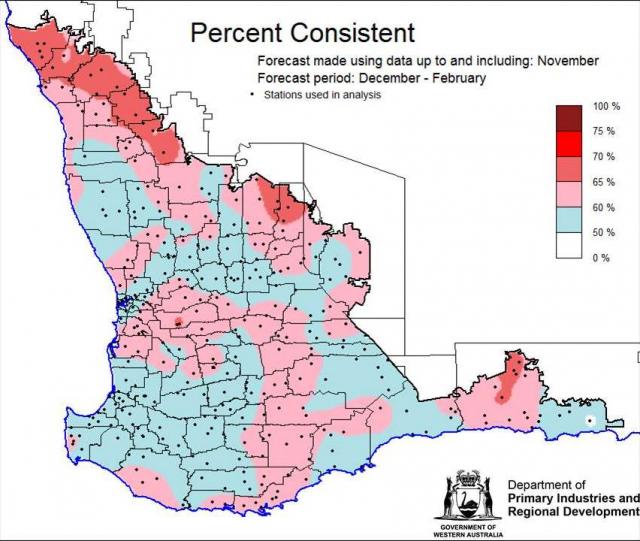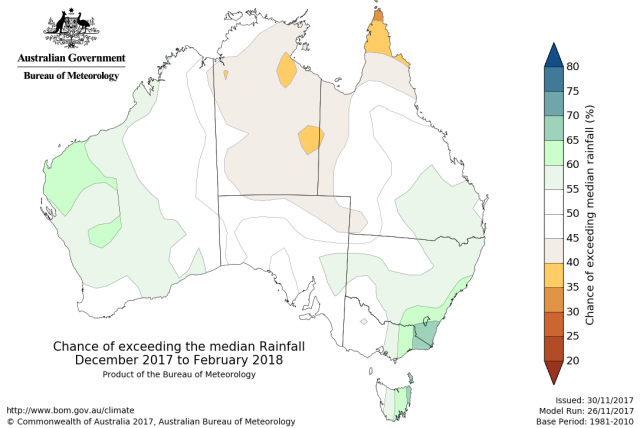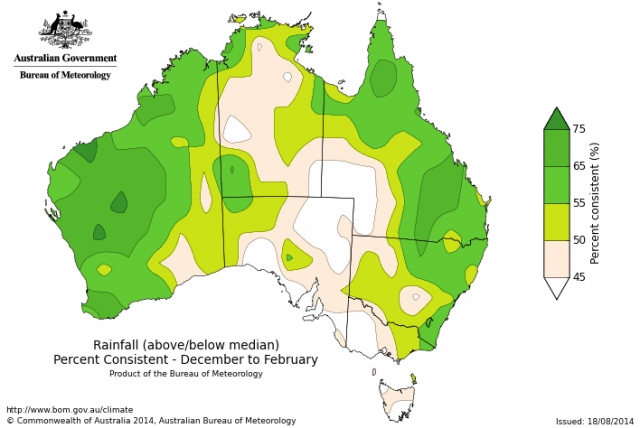Summary
The Department of Primary Industries and Regional Development’s (DPIRD) Statistical Seasonal Forecast (SSF) system is indicating less than 40% chance of exceeding median rainfall for summer, December 2017 to February 2018 for the majority of the wheatbelt.
- The SSF is indicating 60-70% chance of exceeding median rainfall for the far northern agriculture region and south-west corner. This chance has increased to 70-80% for the Perth region. This region typically has low rainfall over summer.There is less than 40% chance for northern, central and eastern agricultural regions, with neutral (40-60%) chances elsewhere. The most probable decile range map indicates decile 2-3 rainfall is most likely for eastern and central wheatbelt, with decile 8-10 rainfall for the far northern wheatbelt and south-west corner and decile 4-7 elsewhere. Predictive skill based on November conditions is poor (50-60% consistent) across most of the region.
- The Bureau of Meteorology’s current seasonal outlook indicates generally a neutral outlook, with 45-60% chance of exceeding median rainfall for summer for the South West Land Division (SWLD). Predictive skill is poor to good (50-75% consistent). For the individual month of December the chance is lower at 35-45%.
- Temperature outlooks for summer, December 2017 to February 2018 from the Bureau indicate a 45-65% chance of above normal day-time maxima for the SWLD. Skill is moderate to good at 50-75% consistent. Minimum temperature outlooks indicate a 55-65% chance of above normal night-time minima for the SWLD, with moderate to good skill at 50-75% consistent.
- November rainfall in the SWLD was below average to near average. November maximum and minimum temperatures were very much above average.
Three month outlook for the south-west of Western Australia
Statistical Seasonal Forecasting (SSF)
DPIRD’s Statistical Seasonal Forecast (SSF) system uses historical relationships between global sea surface temperature and sea level pressure with rainfall in south-west Australia to produce forecasts of rainfall for the coming months. Users can click on any station indicated on the map for location-specific forecast information from the Seasonal Climate Information page.
For summer, December 2017 to February 2018, the SSF is indicating 60-70% chance of exceeding median rainfall for the far northern agricultural region and south-west corner. This chance has increased to 70-80% for the Perth region. This region typically has low rainfall over summer, so the outlook is not necessarily indicating heavy rainfall. There is less than 40% chance for northern, central and eastern agricultural regions, with neutral (40-60%) chances elsewhere. The most probable decile range map indicates decile 2-3 rainfall is most likely for the eastern and central wheatbelt, with decile 8-10 rainfall for the far northern wheatbelt and south-west corner and decile 4-7 elsewhere. Predictive skill based on November conditions is poor to good (50-70% consistent). Note that most of the region has low skill at this time of year.


Bureau of Meteorology seasonal climate outlook
The Bureau of Meteorology’s climate outlooks are generated by a dynamical (physics based) coupled atmosphere-ocean climate model.
The Bureau of Meteorology’s current seasonal outlook indicates generally a neutral outlook, 45-60% chance of exceeding median rainfall for summer for the SWLD. Predictive skill is poor to good (50-75% consistent). For the individual month of December the chance is lower at 35-45%.
On average, there are seven tropical cyclones each season in the western region of Australia. The Bureau’s tropical cyclone outlook is indicating the average number is expected this coming summer. One cyclone (TC Dahlia) has occurred already. Typically between about 15-40% of tropical cyclones in the Western region create coastal impacts. Wheatbelt summer rainfall is generally from localised thunderstorms, but tropical cyclones and tropical lows can generate summer rain if they travel southwards. This was the case in early December with moisture outflow from TC Dahlia.
Temperature outlooks for December 2017 to February 2018 from the Bureau indicate a 45-65% chance of above normal day-time maxima for the SWLD. Skill is moderate to good at 50-75% consistent. Minimum temperature outlooks indicate a 55-65% chance of above normal night-time minima for the SWLD, with moderate to good skill at 50-75% consistent.
The Heatwave Forecast, produced by the Bureau shows the location of heatwaves, severe heatwaves and extreme heatwaves for three-day periods. It may be useful to assist with livestock management or irrigation scheduling for horticulture. The latest bushfire outlook produced by the Bushfire and Natural Hazards Cooperative Research Centre, indicates an above normal bushfire risk for the south-west corner.
Recent climate
November rainfall in the SWLD was below average to near average. Thunderstorms were active across the cropping areas in November, but rainfall was highly variable. While many sites recorded some 10-15mm, some had three times as much. Despite this, total rain in November was below average along the west coast and across the south west, with the south coast and Esperance region being near-average. November maximum and minimum temperatures were very much above average.
In November the atmospheric pressure was near normal over the south-west. The Indian Ocean sea surface temperatures northwest and west of Western Australia were cooler than normal.
A La Niña event has developed in the tropical Pacific Ocean as expected. It remains likely to be a relatively weak and short-lived event. Sea surface temperatures north of Australia are not typical of La Niña, and this weakens rainfall probabilitues across much of Australia. Previous late-developing La Niña’s have had little influence on SWWA in summer.
The Indian Ocean Dipole (IOD) is neutral. Indian Ocean Dipole events are typically unable to form between December and April due to the influence of the monsoon trough over the tropical Indian Ocean. See the Bureau of Meteorology’s IOD and Pacific Ocean interaction for details.
The Southern Annular Mode (SAM), also known as the Antarctic Oscillation (AAO), describes the north–south movement of the westerly wind belt that circles Antarctica, dominating the middle to higher latitudes of the southern hemisphere. SAM is currently positive and is expected to remain positive until the end of December. In a positive SAM event, the belt of strong westerly winds contracts towards Antarctica. In spring and summer, a strong positive SAM can mean that southern Australia is influenced by the northern half of high pressure systems, and hence there are more easterly winds bringing moist air from the Tasman Sea. This increased moisture can turn to rain as the winds hit the coast and the Great Dividing Range. Recent heavy rainfall over south-eastern Australia is likely to come from the positive SAM conditons. However, a positive SAM has no influence on spring/summer rainfall in the SWLD.
The table below gives a summary of past month and three month south-west Western Australia (SWWA) climate conditions and can be used as an indication of what is likely to occur in the near future, if climate conditions follow the current pattern.
| Climate indicator | Past month | Past three months |
| SWWA rainfall | Below average to average | Average to above average |
| SWWA mean temperature | Very much above average | Very much above average |
| SWWA atmospheric pressure | Near normal | Near normal |
| Indian Ocean sea surface temperature | Cooler | Cooler |
| El Niño/Southern Oscillation (ENSO) | Neutral, now La Niña | Neutral |
| Indian Ocean Dipole (IOD) | Neutral | Neutral |
| Southern Annular Mode (SAM) | Positive | Positive |


